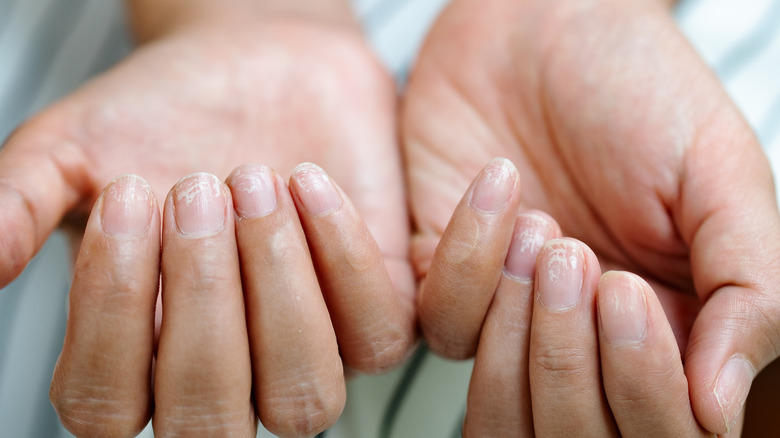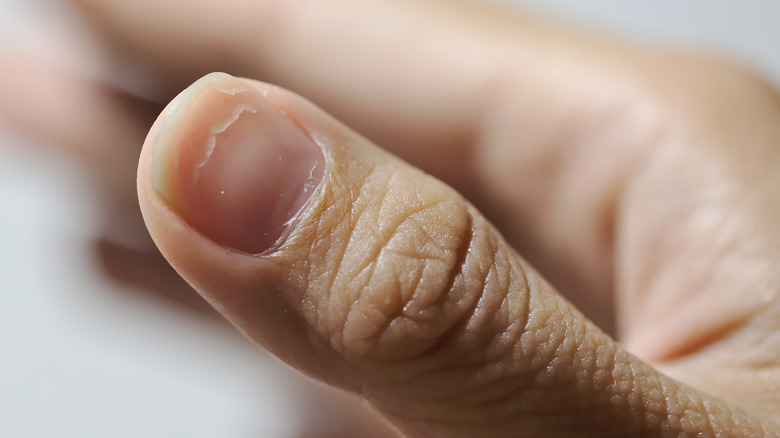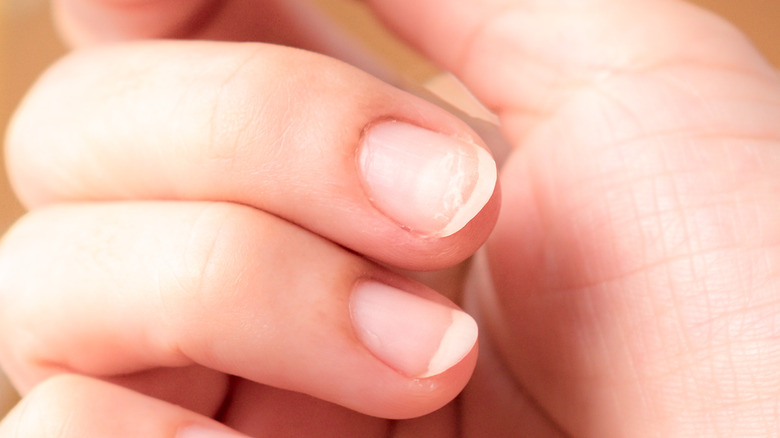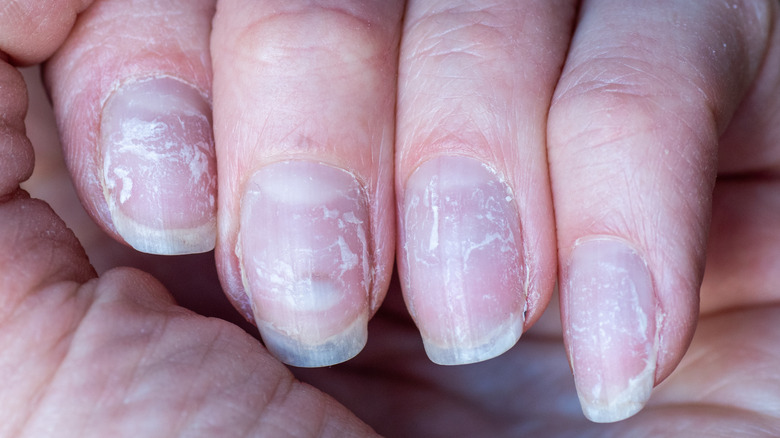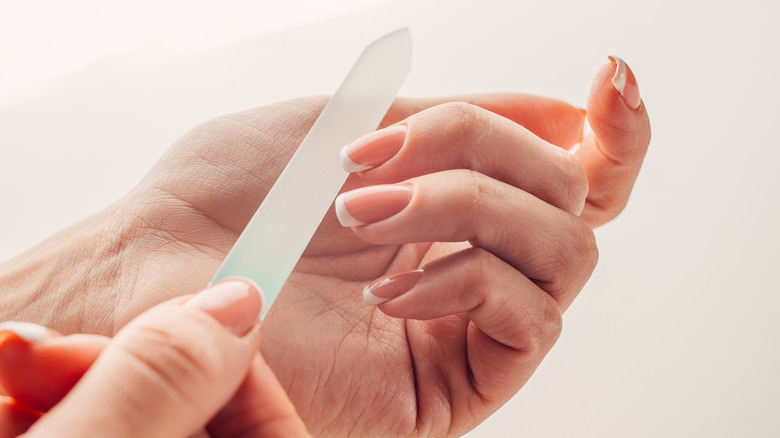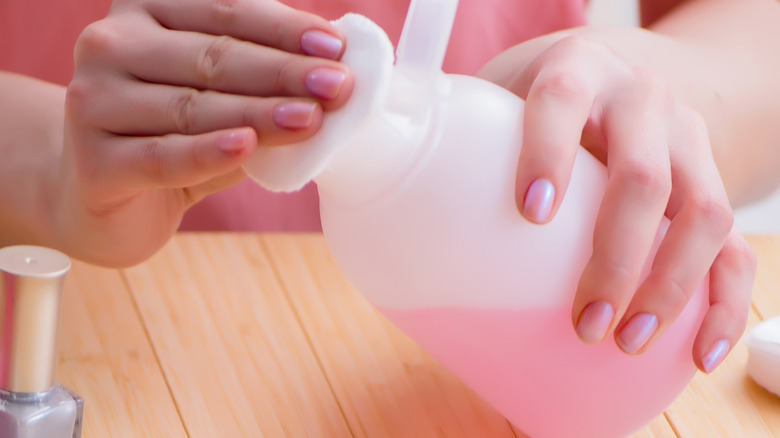Signs You May Have Eggshell Nails (& What To Do About It)
If you're on a quest for healthy and happy nails, any problems you encounter can be frustrating. Perhaps they don't grow at the pace you'd like, or maybe they break easily. Getting the talons of your dreams can be frustrating. Some common nail conditions that people can encounter include brittle nail syndrome and nail psoriasis, to name a few. These conditions can all affect the way your nails look and feel. Eggshell nails, otherwise known as hapalonychia, are another condition many individuals experience. While causes can vary, some of the most common include malnutrition and inherited conditions.
If you suspect that you have eggshell nails, but you're still unsure, then there are various ways that you can figure it out. Likewise, there are also plenty of precautions that you can take to either prevent or treat the problem. Thankfully, these are all relatively easy. So, how do you identify if you have eggshell nails, and what can you do about them?
Your nails have a blueish tint
One way to identify if you have eggshell nails is by investigating the color tint of your nails. If you have eggshell nails, then your nails will likely have a "blueish" tint or be discolored slightly. But what causes this peculiar discoloration? It turns out that the tint is caused by your nails being too thin. This causes "the underlying vasculature of the nail bed [to show] through the thin nail plate," explains board-certified dermatologist Dana Stern, M.D. to Brydie. In other words, you can see your blood circulation closer to the surface of your nail plate that has thinned, hence the blue color.
This change in nail color is one of the most obvious signs that you have eggshell nails. They may even be just more transparent than usual. However, if you are unsure, it is always best to check with your doctor, who will be able to identify any nail problems you may have accurately. However, having a blue tint in your nails isn't the only sign.
The ends of your nails are flaky or split
Aside from the color of your nails, the physical feel of your nails can also be a giveaway of the condition. Individuals with the condition often experience flaky and split nails, particularly at the ends, hence the name "eggshell."
In addition, your nails may feel weak and thin, which may cause them to snap and break more easily. While it's normal for nails to break occasionally, it's usually a bigger problem for individuals with the condition. As a result, you may experience frequent snapping and nail breakage, so it is essential to be careful when using your hands in day-to-day life. Nail snapping paired with very transparent or tinted nails may very well mean that you have eggshell nails. However, it is always best to check with your doctor. While this may be frustrating, there are some steps you can take to encourage the healthy growth of your nails and minimize the impact of eggshell nails.
How to prevent eggshell nails
Before treating your eggshell nails, it is essential to note that you must first find what is causing them. It is always best to seek professional advice to ensure you get an accurate and trustworthy answer. Once you have an answer, they should be easier to treat. In the meantime, there are some simple steps that you can take to help both treat and prevent eggshell nails.
If you suspect that you have been suffering from the condition for a long time, one measure you can take is to actively make sure that you avoid harsh chemicals. You should also ensure not to submerge your nails in water for long periods, as doing so (particularly in warm or hot water) can temporarily weaken them, encouraging further snapping. However, sometimes these situations can be challenging to avoid, such as washing up or cleaning. In cases such as these, wearing gloves may help. Consider using cold water where possible and for shorter periods.
Use a glass nail file
Eggshell nails are very prone to breakage, as well as being quite soft. For this reason, taking good care of your nails is essential in order to keep them in check and prevent any unecessary breakage. Talking to Brydie, Stern M.D. recommends swapping out your normal nail file for a glass nail file, explaining that: "Traditional emery boards cause microscopic tears at the tip of the nail that leads to splits and peeling." In comparison, glass nail files are much more gentle and seal keratin layers together at the end of the nail, meaning that you are much more likely to keep them in better condition. Using a traditional nail file may only add to your problem and cause more nail snapping.
In addition to using the correct nail file, you should also keep your hands and nails in good condition by keeping them moisturized and treating them to regular upkeep. While it may not be a magic fix, it is certainly a good habit to get into. However, if there is an underlying cause, then that will need to be looked at first. This will help you to get your nails back to their best condition.
Avoid certain nail products and extreme temperatures
If you have eggshell nails, then avoiding certain nail products is important. As well as avoiding harsh chemicals, as mentioned earlier. You should also stop using nail polish remover on your nails, as it contains acetone. The acetone may dry out your nails and aggravate the problem more. For this reason, you should also avoid nail polish, as you must use a remover to get it off. Instead, you should try and keep them as moisturized as possible.
As well as avoiding drying products, you should also avoid extreme cold and heat. The extreme fluctuations in temperature can make your nails go dry and brittle, both of which can worsen eggshell nails. Brittle nails can often lead to snapping and breakage, a problem you may already be dealing with due to your soft and thin nails.
However, while all of these tips may help, you must find out the underlying cause so that you can adequately treat your eggshell nails.
